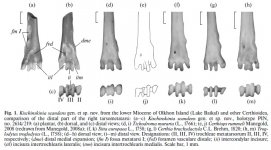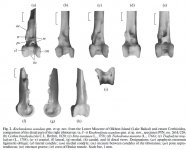Fred Ruhe
Well-known member

Natalia V. Volkova; Nikita V. Zelenkov, 2018.
КОГТЕЛАЗАЮЩАЯ ВОРОБЬИНАЯ ПТИЦА (PASSERIFORMES, CERTHIOIDEA) ИЗ ВЕРХОВ НИЖНЕГО МИОЦЕНА ВОСТОЧНОЙ СИБИРИ
Paleontological Journal. 52
Abstract:
A Tree-Climbing Passerine Bird (Passeriformes, Certhioidea) from the Uppermost Lower Miocene of Eastern Siberia
Volkova N.V., Zelenkov N.V.
A tree-climbing passerine bird, Kischinskinia scandens gen. et sp. nov., is described from the uppermost lower Miocene of Olkhon Island (Tagai locality; Lake Baikal) based on distal tarsometatarsus and provisionally referred distal tibiotarsus. Both tibiotarsus and tarsometatarsus display features indicative of climbing adaptations. Earlier, a related form belonging to the clade Certhioidea was described from the early Miocene of Germany. These two fossil tree-climbing birds, along with some other taxa, indicate close affinities between the early Miocene avifaunas of East Asia and Western Europe. Kischinskinia scandens is the first Asian representative of the clade Certhioidea and further is the oldest representative of songbirds (Oscines) in Asia.
The German species is Certhiops rummeli Manegold, 2008.
Enjoy,
Fred
КОГТЕЛАЗАЮЩАЯ ВОРОБЬИНАЯ ПТИЦА (PASSERIFORMES, CERTHIOIDEA) ИЗ ВЕРХОВ НИЖНЕГО МИОЦЕНА ВОСТОЧНОЙ СИБИРИ
Paleontological Journal. 52
Abstract:
A Tree-Climbing Passerine Bird (Passeriformes, Certhioidea) from the Uppermost Lower Miocene of Eastern Siberia
Volkova N.V., Zelenkov N.V.
A tree-climbing passerine bird, Kischinskinia scandens gen. et sp. nov., is described from the uppermost lower Miocene of Olkhon Island (Tagai locality; Lake Baikal) based on distal tarsometatarsus and provisionally referred distal tibiotarsus. Both tibiotarsus and tarsometatarsus display features indicative of climbing adaptations. Earlier, a related form belonging to the clade Certhioidea was described from the early Miocene of Germany. These two fossil tree-climbing birds, along with some other taxa, indicate close affinities between the early Miocene avifaunas of East Asia and Western Europe. Kischinskinia scandens is the first Asian representative of the clade Certhioidea and further is the oldest representative of songbirds (Oscines) in Asia.
The German species is Certhiops rummeli Manegold, 2008.
Enjoy,
Fred





